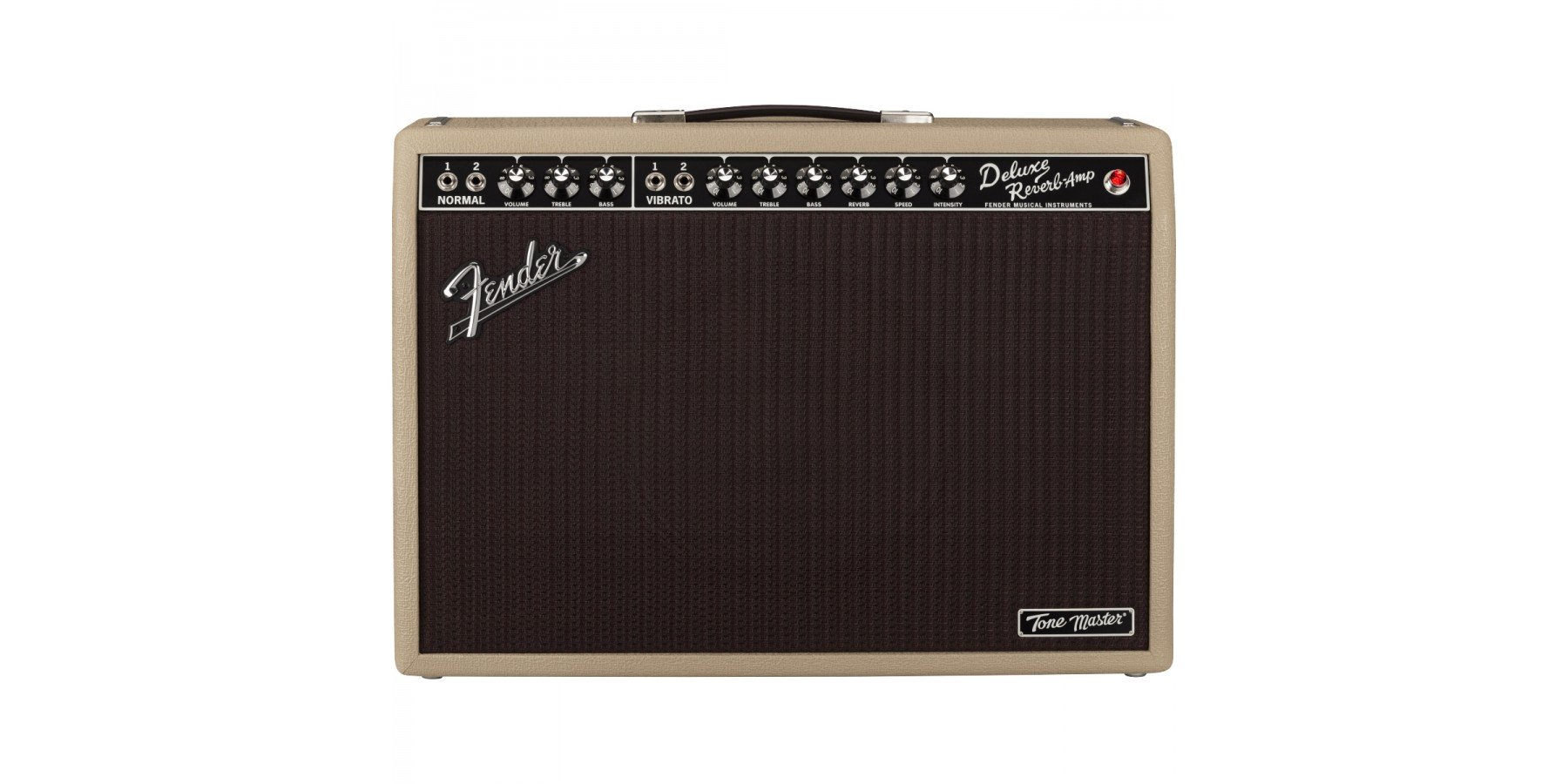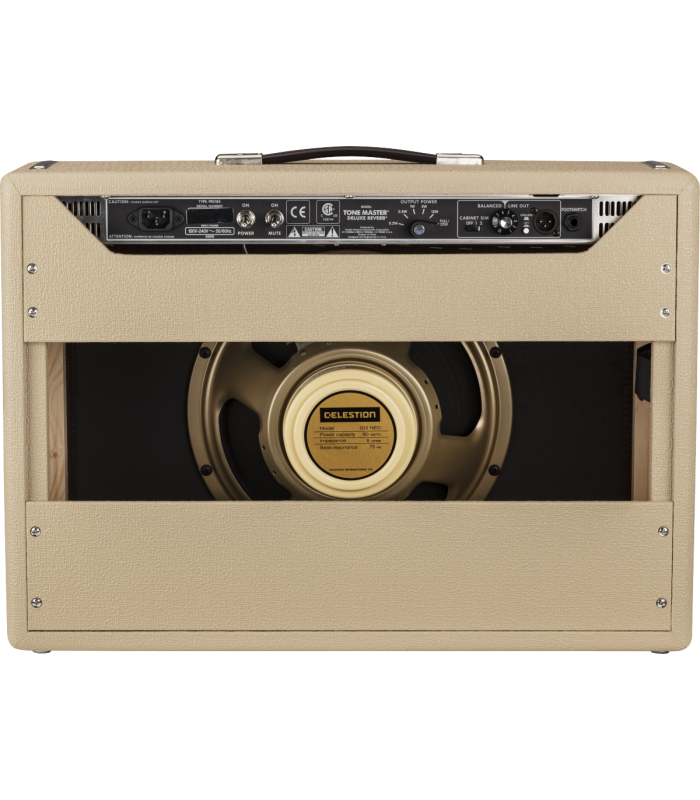Review : Fender Tonemaster Deluxe Reverb Blonde
Fender Tonemaster Deluxe Reverb Blonde
Introduction
I bought this amp on a Black Friday sale. I did not and do not need another amplifier, but this one was priced absolutely right and sounds awesome. That comment, coming from someone who until now has eschewed any amplifier that did not use tubes/valves is quite a statement. I do use DSP devices for recording including a Neural Quad Cortex and a Kemper Stage, but this is the first time I have spent my money to own a digital amplifier for practical use. The Tonemaster Blonde is audibly different from the standard Tonemaster and that difference made the difference between just playing one and choosing to buy one and play it.
Rear View - note the Celestion Creamback speaker
About the Amplifier
Auditory memory on its best day sucks when it comes to recalling tone. That is a fact. Having played the original Tonemaster Deluxe Reverb amp side by side with a black face ‘64 Reissue Deluxe Reverb, they sounded the same in a blind side by side. They felt a bit different in the room, but at a distance or on a recording, neither I nor anyone else has been able to say which one is which.
Such is the sound quality of the Tonemaster family. I have also done blind side by side tests with tube Super Reverb and the Tonemaster Super Reverb with the same success. Let’s be clear though, they are very different amplifiers. First off, the cabinets are pine, not Baltic Birch so there is immense weight savings. There are no tubes, so they are pretty much instant on. Instead of the Standby switch, there is a Mute switch to decouple the speaker but leave the DI out signal intact. Except in the Super Reverb variant, the speakers are Neodymium so a lot lighter than a traditional speaker. The front panels are pretty much identical and if there was not the Tonemaster plate on the lower right front, you’d be hard pressed to know. I’ve even encountered those who removed the Tonemaster plate so viewers might think it was a tube amp. I will reserve comment on that level of insecurity.
On the back panel, you will find an attenuator that goes from full power, referred to as 22 watts* down to 0.2 watts. The asterisk means that this is not really a 22 watt amplifier. It is a DSP amplifier and as such is actually a 100 watt amplifier in construction. So this Tonemaster gets as loud as a 22 watt tube amplifier, while its power section is putting out 100 watts. I only care about the sound, and to me it sounds very good. I recommend using the attenuator to get the amp into what to me is the sweet spot, with the volume pot about 6 1/2. There is also an XLR balanced DI out and the option of including one of two impulse response profiles in the DI signal, or no IR at all if you prefer to add one in post processing. The included IRs feature either an SM57 aimed at the edge of the speaker cone centre cap, or a Sennheiser MD 421 aimed at the edge of the speaker cone centre cap. In my review of the Epiphone Sheraton II Pro, I used this amp DI into the UA interface and recorded with both IRs. The SM57 is a bit brighter and the MD 421 is a bit thicker, just as you would expect of these microphones in the real world. You can also control the output level of the DI signal at the amplifier. This is particularly handy if you want to use a specific preamp plugin on the interface input and want a bit more range on the virtual preamp. At time of this writing, I have only tried this a bit, and have found that I might use a UA Unison Neve preamp for a slightly warmer signal without giving anything up. That said, the signal from the amp is perfectly usable without any plugins at all.
The Blonde version is different from the original black version, and I personally prefer it. They cost the same (I think) but the blonde ones are rarer. The primary differences are that the Blonde has the virtual bright cap removed, has a Neodymium Celestion Creamback instead of the Neodymium Jensen that is in the black model, and has a refined reverb control for finer control of the reverb at low volumes. Let’s be clear that this is digital reverb, there are no springs here, and credit to Fender for doing a really nice job on the reverb. It sounds terrific. To see the full specs of the amp click here as finding anything on Fender’s own website is a real pain in the butt unless you force yourself onto the USA site and are prepared for links not to work.
The amplifier comes with a two button footswitch to punch the reverb in or out, and to control what Fender calls the Vibrato. As is common with Fender, once upon a time, someone got tremolo and vibrato mixed up and the wrong naming has stuck. It’s not vibrato, it’s tremolo and it’s decent enough if you like that sort of thing. Since tremolo incites an immediate pounding headache for me, I expect it to be off almost always.
Unlike a load balancing attenuator on a tube amp, I do not notice a tonal change when increasing the level of attenuation on the Tonemaster. I have external attenuators for my old 100w Marshalls and there is one built into my Tone King Imperial Mark II. They are all very good, but if you’ve heard these amps untouched, there is a subtle difference when attenuation is engaged. So far, I do not hear that in this Tonemaster.
Build quality is excellent and the amplifier certainly looks the part. More importantly, it sounds the part. I have a reasonable assortment of Fender tube amps and my go to has been a blackface Twin Reverb for a while. Twins sound different from Deluxes, and this Tonemaster Deluxe makes a nice complement to the tube driven Twin and is certainly a lot easier to move around. Some of the images on the Internet suggest that the Tonemaster Deluxe has tilt back legs. Perhaps they do in some markets, this one, brand new out of the box, does not.
Different Guitars and Pedal Friendliness
Different guitars result in different responses from an amplifier. One of the things that makes the Deluxe Reverb so popular is how agile it is with different guitars and pickups. It works well with everything that I have tried through it so far which include the Epiphone Sheraton II Pro, an old Epiphone Joe Pass jazzer, a Gretsch Thinline Electromatic, a Les Paul Axcess with hot humbuckers my modded Classic Vibe Squier Telecaster to be a Keith Richards version and of course Strats. I keep moving away from the keyboard to play the US Strat Ultra because it just sounds so lovely, especially in positions 2 and 4. Thus, I would say that the Tonemaster Deluxe Reverb is an excellent choice for most guitars and players. I don’t use heavy distortion or fuzz and don’t play any types of metal so I am not qualified to comment in those genres.
It also takes pedals really well. While I am not a fan of Tube Screamers, I do enjoy very much the Origin Systems Halcyon, which is their Tube Screamer I suppose. The amp also takes the MXR Duke of Tone very well and I use a Keeley D&M Drive with the boost (Mick side) always on at unity gain. If I want some delay, it sounds great with the Eventide TimeFactor and for modulation, on this board, there is an Eventide ModFactor. If I want shimmer and special reverbs, there is TC Electronic Hall of Fame 2, but I use it rarely with the Tonemaster because the simple built in reverb is so pleasing.
Audio Samples
In these two audio samples, the guitar was used without any effects in front of the amp and with no effects added in post processing. The first audio sample is a Fender US Ultra Stratocaster playing the same riff and same chords in switch positions 4 and 2. It is the de facto Strat sound in my opinion. The second audio sample is a Gibson Les Paul Axcess with humbuckers in neck and bridge positions. No coil taps were engaged on the Les Paul. Both guitars had volume and tone pots at ten. The amplifier volume was at 5, bass and treble at 6, reverb at 3 and tremolo circuit off. I used the IR for the Shure SM57 microphone as explained above for the samples and went DI from the amp into the Universal Audio Thunderbolt Apollo Solo and recorded everything in Studio One v6. No post processing was used at all, not even my go to Teletronix LA-2A.
Conclusions
I’ve been auditioning Tonemasters since their first release and even did a demo session with the Deluxe and the Twin Reverb versions at my local music shop when the scheduled demonstrator was unavailable. I have come close in the past to buying the Super Reverb version because I like the sound of that cabinet so much, but have held off. When I first heard the blonde versions, I was surprised at the difference from the black versions and at how much they appealed to me. As I already own a blackface Twin Reverb, the Tonemaster Deluxe Reverb Blonde is a good fit for me. It has that Deluxe tone that I like, and I do appreciate the Celestion Creamback speakers very much. Thus I now have a great sounding, light and transportable amplifier that is also superb for direct recording. At less than half the price of a tube based Deluxe Reverb and less than one third the price of the hand wired reissue, it’s quite a bargain without compromising tone.
NOTE : Reader Bob pointed out that I made an erroneous statement pertaining to wattage in solid state amps vs tube based amps. I sincerely appreciate the correction and the invalid statement has been removed.


